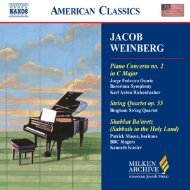Download Liner Notes PDF - Milken Archive of Jewish Music
Download Liner Notes PDF - Milken Archive of Jewish Music
Download Liner Notes PDF - Milken Archive of Jewish Music
Create successful ePaper yourself
Turn your PDF publications into a flip-book with our unique Google optimized e-Paper software.
<strong>of</strong> the <strong>Jewish</strong> Peoples Philharmonic Chorus, conducted<br />
by the composer. (Inexplicably, the chorus—essentially<br />
the same one Helfman had begun directing in<br />
1937—billed itself then as the People’s Philharmonic<br />
Choral Society, although it subsequently returned to<br />
its earlier name.) That performance also included an<br />
important dance component and staging by Benjamin<br />
Zemach, the eminent choreographer and creator <strong>of</strong><br />
modern <strong>Jewish</strong> dance forms. Dance was also part <strong>of</strong><br />
subsequent performances in Montreal (1949), in Los<br />
Angeles at the Wilshire-Ebell Theater (1950) where it<br />
was sung by the <strong>Jewish</strong> People’s Chorus, and in Santa<br />
Monica, California (with full orchestra), among other<br />
venues. The work was featured by the <strong>Jewish</strong> Peoples<br />
Philharmonic Chorus in its 1964 memorial tribute to<br />
Helfman, performed at New York’s Town Hall.<br />
As a composer, Helfman was essentially a miniaturist<br />
who excelled in the smaller forms. More than once<br />
he expressed to close associates and friends his regret<br />
that he had never written, or had the patience to<br />
complete, a magnum opus. Of all his works, however,<br />
Di naye hagode, with its overall musical-structural<br />
arch, its sense <strong>of</strong> inspired artistic unity, and its judicious<br />
balance, probably comes closest to that wish. Indeed,<br />
the consensus among those familiar with his music has<br />
long been that this was Helfman’s most ambitious and<br />
most powerful work.<br />
ḤAG HABIKKURIM<br />
Helfman’s choral pageant Ḥag habikkurim (Festival<br />
<strong>of</strong> the First Fruits) is a suite <strong>of</strong> original arrangements<br />
<strong>of</strong> modern Hebrew songs that were sung in Palestine<br />
during the decades prior to independence—as well as<br />
during the early years <strong>of</strong> the State <strong>of</strong> Israel—by the<br />
<strong>Jewish</strong> colonists and pioneers who, imbued with Zionist<br />
ideals <strong>of</strong> national return and reconstruction, had gone<br />
there to reclaim, rebuild, and resettle the land as a<br />
<strong>Jewish</strong> national home. These songs, which represented<br />
the new Zionist-oriented spirit <strong>of</strong> national rejuvenation,<br />
cultural renaissance, and agricultural revival, and which<br />
also provided a link to <strong>Jewish</strong> antiquity, were created or<br />
adapted for the most part by songwriters, composers,<br />
and poets who were active in the yishuv (the <strong>Jewish</strong><br />
communal settlement in Palestine under the British<br />
Mandate). Helfman stitched them together into a quasidramatic<br />
and multimedia presentation that, ideally,<br />
also includes dance, costumes, processions, pantomime,<br />
spoken lines, and a narration (now a bit dated) by Ruth<br />
Bardin, the wife <strong>of</strong> Shlomo Bardin (director <strong>of</strong> the<br />
Brandeis Camp). This pageant <strong>of</strong>fers a capsule history<br />
<strong>of</strong> the pioneers’ constructive accomplishments from<br />
the earliest wave <strong>of</strong> immigration in the 19th century<br />
until the late 1940s. The pageant was conceived as an<br />
American reflection—and not necessarily an actual<br />
replica—<strong>of</strong> the spring harvest kibbutz festival, ḥagigat<br />
habikkurim, which, even long after independence, was<br />
usually reenacted during or on the pilgrimage Festival<br />
<strong>of</strong> Shavuot as a kind <strong>of</strong> secular substitute celebration for<br />
that religious holyday. Shavuot is known in the liturgy<br />
as ḥag habikkurim, from the references in Exodus 23:16,<br />
34:22; Leviticus 23:16–17; and Numbers 28:26.<br />
Bikkurim, or “the first fruits,” refers historically and<br />
biblically to the portion <strong>of</strong> each season’s harvest,<br />
including the first grains to ripen each season, that—<br />
in accordance with biblical pronouncements and legal<br />
injunctions—were required to be brought to the<br />
Temple in Jerusalem as a sacrifice by every Israelite<br />
who had the means <strong>of</strong> agricultural production.<br />
Detailed ceremonial procedures for the <strong>of</strong>ferings <strong>of</strong><br />
the first fruits are found in Deuteronomy 26:1–11,<br />
although there are discrepancies between certain<br />
aspects <strong>of</strong> the rites as described therein and other<br />
references in Leviticus. In antiquity, considerable<br />
ritual and pageantry accompanied the <strong>of</strong>ferings<br />
<strong>of</strong> the bikkurim, which constituted both a personal<br />
obligation and a festive public celebration. During the<br />
Second Temple era, the pilgrimage to the Temple to<br />
<strong>of</strong>fer the bikkurim could occur anytime between the<br />
Festivals <strong>of</strong> Shavuot and Sukkot—i.e., between late<br />
spring and autumn (Mishna Bikkurim 1:3).<br />
Kibbutz festivals, such as the one corresponding to<br />
Shavuot (ḥagigat habikkurim), originated during the<br />
1920s and 1930s in Palestine. They were instituted<br />
partly as an educational experience, especially for<br />
19 8.559440<br />
Helfman_<strong>Liner</strong>Nts 9440.indd 19<br />
12/5/05 1:03:56 PM
















